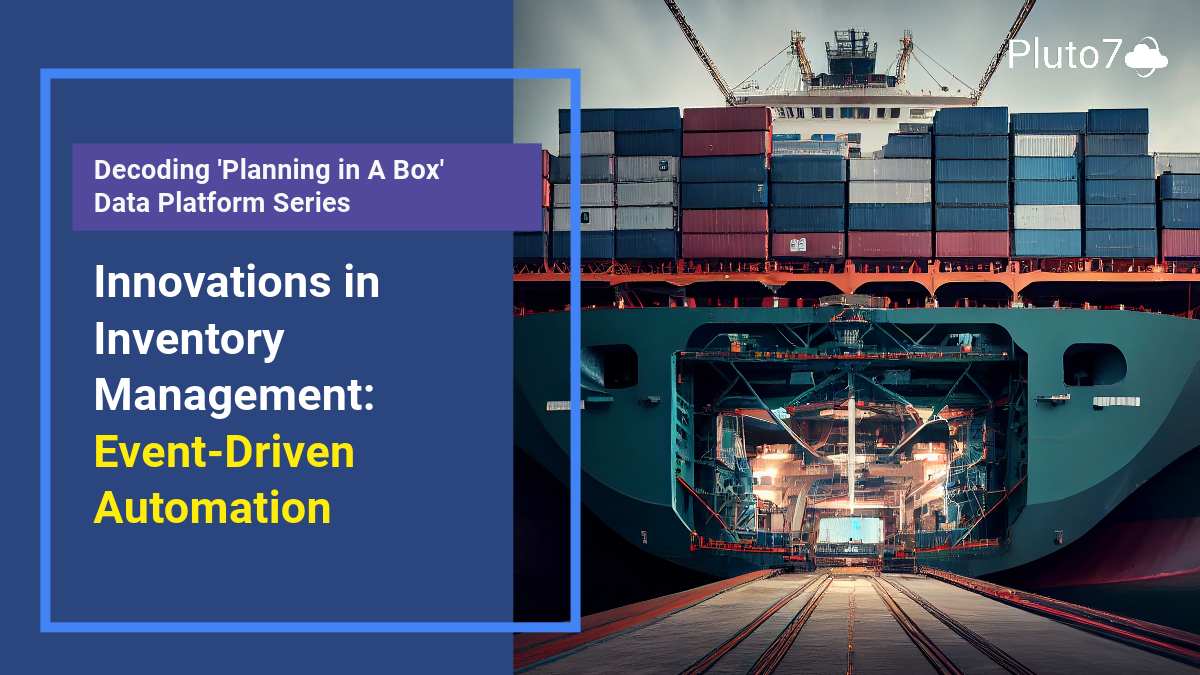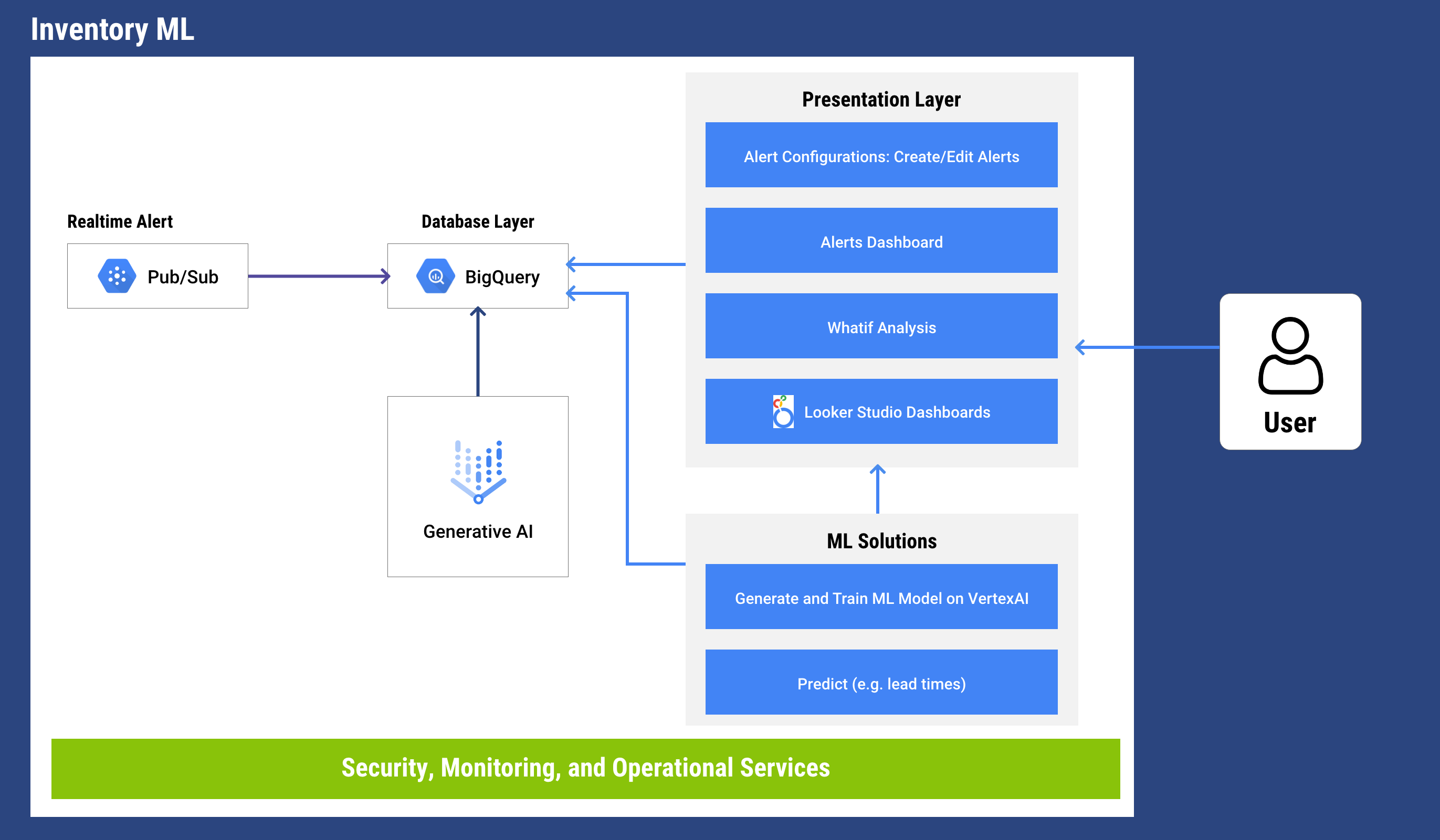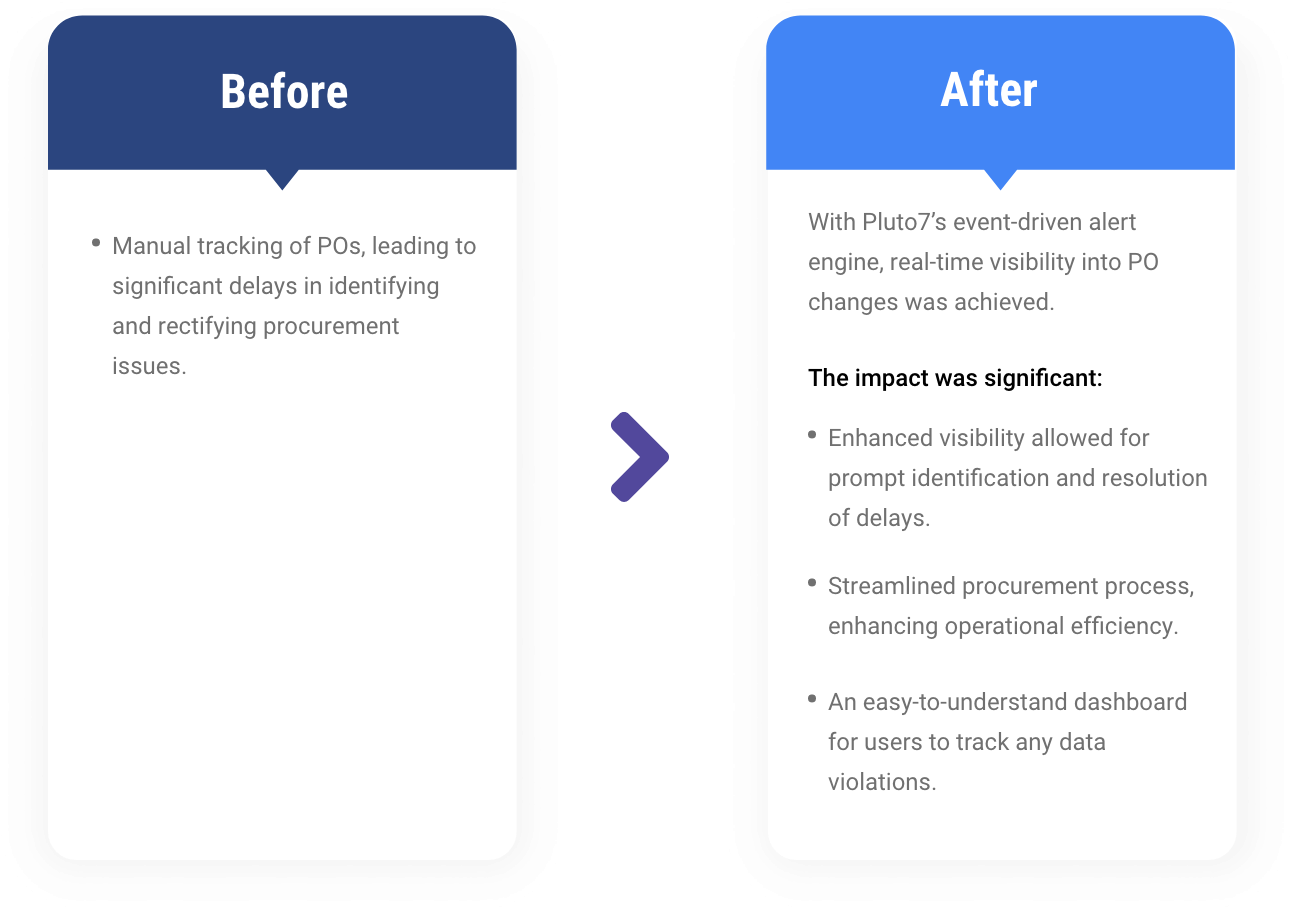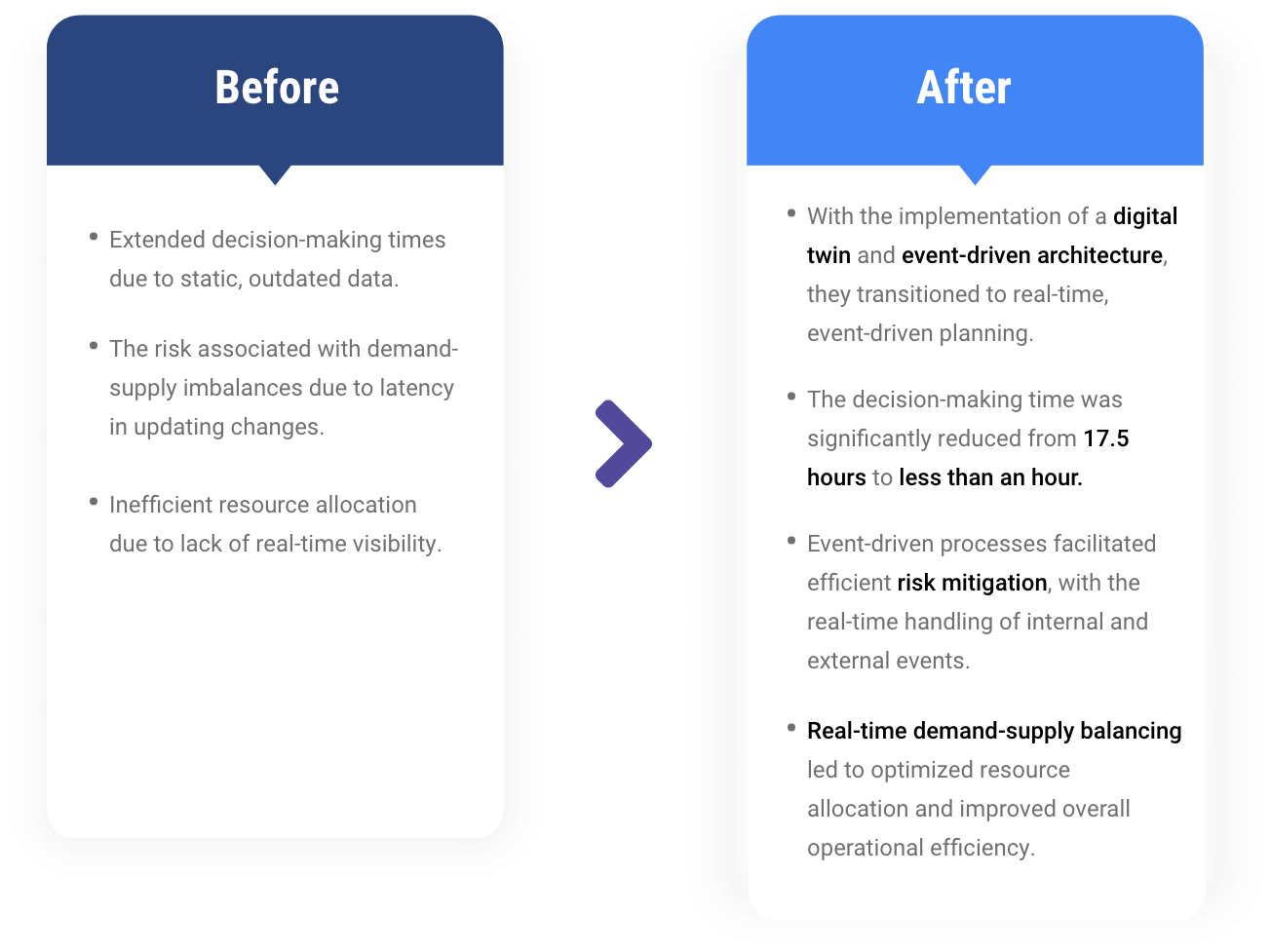
Transform Your Supply Chain Planning and Marketing Strategies with Google Cloud and SAP Integration

Transform Your Supply Chain Planning and Marketing Strategies with Google Cloud and SAP Integration
July 13, 2023 | Asheesh Gupta
Blog / Innovations in Inventory Management: Event-Driven Automation
In a world where businesses have sprawling global supply chains, a disruption in one corner of the world can create a domino effect that impacts operations worldwide.
Consider this example: A multinational company sources raw materials from Brazil, but a sudden transport strike there brings the supply to a halt. With no visibility into when the strike might end and when the goods will arrive, the planner sitting at the headquarters in Chicago faces a complicated problem.
To make an informed decision about managing inventory and maintaining business continuity, the planner needs answers to several critical questions:
Traditionally, finding answers to these questions would involve numerous emails, phone calls, and manual data analysis, taking up valuable time and resources. However, with event-driven automation, the situation is drastically different.
Event-driven automation can provide real-time updates on the situation, calculate the potential impact on the supply chain, and even suggest alternate sourcing strategies. By providing these insights and recommendations instantly, event-driven automation enables the planner to make quick, informed decisions, ensuring that the company can maintain its operations despite unexpected disruptions.

Event-driven automation, a pivotal concept in modern computing, is an approach where business processes and decisions are automated and triggered by events. According to IDC, “event-driven architecture (EDA) will be a top three priority for 70% of global enterprises by 2024, reducing latency in decision making, improving operational efficiency, and enabling real-time business processes.”
An event is a signal or ‘trigger’ that initiates an action within a business environment. This could range from a customer placing an order, a machine’s temperature sensor detecting overheating to sudden changes in a supplier’s status, like a transport strike affecting deliveries.
To provide a clearer picture of the potential of event-driven automation, let’s look at it through the following examples:
Demand Planner Joe and Real-time Inventory Management: Traditionally, Joe would determine the reorder levels for items based on past trends and manual inputs, a method that has its limitations. However, with event-driven automation, Joe can now monitor inventory levels in real-time. As soon as the quantity of an item dips below a specific level, an automatic reorder is triggered. This ability to adjust reorder quantity and timing based on real-time demand trends reduces the risk of stockouts or excess inventory.
Supply Chain Manager Jane and Handling Supply Chain Disruptions: When faced with unexpected disruptions like a transport strike, Jane is often left in the dark about when to expect the delivery of critical raw materials. Event-driven automation changes this by tracking and analyzing real-time data from various sources. This empowers Jane with actionable insights about the current situation and helps her devise alternative strategies, ensuring minimal impact on the supply chain.
Customer Service Rep Amy and Proactive Customer Service: In the past, Amy often learned about potential order delays when it was too late to take corrective action. Now, with event-driven automation, the moment there’s a delay in the supply chain, it triggers a notification to Amy. This gives her a chance to proactively inform the customer about the situation and manage their expectations effectively.

In an event-driven architecture, the key components include the event producer, event router, and event consumer. The event producer creates an event as soon as a state change occurs, which is then transmitted through the event router. The event consumer, listening for specific events, then acts upon receiving the event.
The beauty of this architecture lies in its asynchronous nature. The event producer does not need to be aware of the event consumer, thus promoting decoupling and scalability. Furthermore, as multiple consumers can listen for the same event, it enables parallel processing, enhancing the system’s overall responsiveness and performance.
Streamline. Automate. Reduce Inventory Costs.
Minimize Wastage and Unlock Efficiency and Savings
With its powerful capabilities, event-driven planning can solve a host of business problems that traditional systems may struggle with.
By constantly monitoring sales and other relevant data streams, an event-driven system can predict demand surges or falls with higher accuracy and take immediate action.
An event-driven system can identify potential disruptions in the supply chain, like delays from a supplier or changes in freight costs, and adjust the operations accordingly in real time.
By having real-time visibility into inventory across all warehouses and stores, an event-driven system can make informed decisions about stock replenishment, reallocation, or markdowns.
Using event-driven architecture, businesses can build AI-based assistants that make routine decisions, freeing up human resources to focus on strategic tasks. These assistants can monitor data streams, make decisions based on predefined rules, and learn from the outcomes to continually improve their decision-making.
Pluto7, leveraging Google Cloud’s robust capabilities, empowers businesses to transition from snapshot-based to event-driven planning. Google Cloud offers a highly scalable and reliable infrastructure along with advanced data and analytics services, making it an ideal platform for implementing an event-driven architecture.
On top of Google Cloud, Pluto7 has built a suite of AI and ML solutions that interpret the incoming stream of events, recognize patterns, make predictions, and trigger appropriate actions. With this powerful combination, Pluto7 brings the power of event-driven architecture to businesses of all sizes and shapes.
Using Google Cloud’s powerful data analytics and machine learning tools, Pluto7’s decision intelligence platform ‘Planning in a Box’ is able to gather, analyze, and visualize over 250+ external signals. This provides users with enriched contextual insights, allowing for informed decision-making in all areas – demand, supply, production, and distribution.
It optimizes inventory management and transportation planning by triggering actions based on specific events in real time, resulting in enhanced resource allocation and cost efficiency.
Through the integration of real-time demand signals, Pluto7’s decision intelligence platform ‘Planning in a Box’ transforms the way businesses plan and forecast. This dynamic, demand-signal driven approach enables businesses to anticipate market changes and adjust their strategies accordingly.
The centralization of all data in Google’s BigQuery allows for an integrated, holistic view of the business. This ensures consistent, accurate, and actionable insights are delivered, transforming the way businesses analyze and use their data.
Planning in a Box’s event-driven architecture enables end-to-end visibility across the supply chain network. This offers an unprecedented view into the supply process, from manufacturing to distribution, thereby enabling proactive decision-making and efficient resource management.
A world-renowned furniture retailer was grappling with delays in meeting milestones in their procurement process. They had no tool to capture the changes in the Purchase Orders (POs). Pluto7 came up with an alert engine that detected any data violations based on the latest incoming data. The violations were captured and presented to the user in an easy-to-understand dashboard. This real-time tracking enabled the company to identify and rectify delays in a timely manner.

A global beverage manufacturer with a vast and complex supply chain spanning several countries was grappling with managing the demand-supply balance. The company struggled with inaccurate demand forecasting, due to their reliance on conventional systems that operated on snapshot-based planning. This meant forecasts could only be updated periodically, not in real-time, causing them to frequently face issues of over-production and shortages. The result was not just logistical challenges but also substantial financial implications due to resource wastage and lost opportunities.

As businesses across the world continue to grapple with the challenges of an ever-changing environment, transitioning to event-driven planning can offer them a way to become more responsive and agile. By leveraging Google Cloud’s robust capabilities, SAP users can tap into the power of event-driven planning and transform their operations.
Participate in our 1:1 Personalized Workshop, where together we’ll explore the practical use cases of event-driven architecture, setting the stage to initiate a pilot that ensures actionable results within just 4 weeks.
ABOUT THE AUTHOR